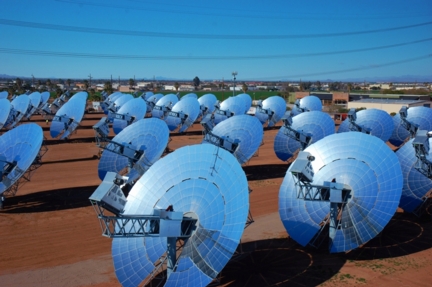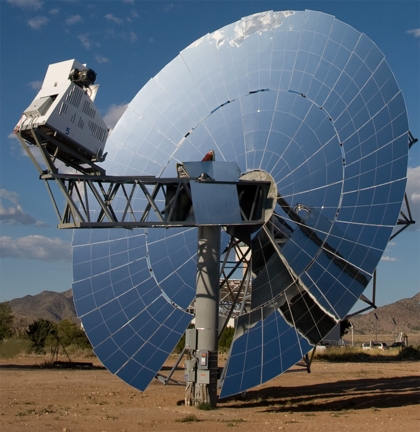I have heard from people in Colorado where 6000 of the SunCatchers are to be placed that the sound of this engine is very disruptive. I feel that sound/noise should be a feature that is always described to buyers, clients and those affected by placement. What studies have been done on how the sound of so many in a large facility will affect local wildlife and nearby residents?
Blog Post
Stirling SunCatcher with "Heat Engine" Technology

Well, it appears that the wait is over.* (see below)Stirling Energy Systems is now manufacturing the SunCatcher, a large, tracking, concentrating solar power (CSP) dish collector that generates 25 kilowatts (kW) of electricity in full sun. Each of the 38-foot-diameter collectors contains over 300 curved mirrors (heliostats) that focus sunlight onto a power conversion unit, which contains the Stirling engine. The dish uses dual-axis tracking to follow the sun precisely as it moves across the sky. To understand why I'm excited about the Stirling SunCatcher you have to understand how a Stirling engine differs from steam engines and steam turbines. Stirling engines are closed-cycle engines (sometimes called "external-combustion" engines) in which an external heat source heats air or another gas, such as helium or hydrogen, in one of the cylinders. The expanding gas pushes a piston, which compresses gas in the cooler portion of the engine. The SunCatcher uses hydrogen in an advanced, four-cylinder design. Concentrated heat from the sun is the external heat source to drive the process. No water or steam is involved--which has very significant implications, since places with a lot of sunlight where CSP applications are most cost effective are also usually very dry.
In January, 2010, four months after breaking ground, Stirling Energy partner company Tessara Solar completed the 1.5 MW Maricopa Solar power plant in Peoria, Arizona, just outside Phoenix. The power plant is comprised of 60 SES SunCatchers. The Maricopa plant is considered a demonstration plant; Tessara hopes to break ground on much larger plants in California and Texas, totaling 1,500 MW of capacity, later this year.

The Stirling SunCatcher differs from BrightSource technology--and that of a somewhat different technology that is used in the Solar Energy Generating Stations (SEGS) plants that have been operating since the early 1980s--in how the heat is converted into electricity. Most CSP systems, including BrightSource, uses the heat to boil water, creating high-pressure steam that then spins a steam turbine. Thus, these CSP systems require water to operate. The SunCatcher does not consume water, since the Stirling engine uses sealed, hydrogen-filled cylinders to convert thermal energy into electricity.
One thing is for sure: the next year will be an exciting period for large-scale solar thermal plants. Keep watching!
For more information:
SUPPORT INDEPENDENT SUSTAINABILITY REPORTING
BuildingGreen relies on our premium members, not on advertisers. Help make our work possible.
See membership options »Stirling Energy Systems
Scottsdale, Arizona
602-957-1818
www.stirlingenergy.comTessara Solar
Houston, Texas
713-554-8484
I invite you to share comments on this blog.
Alex Wilson is the executive editor of Environmental Building News and founder of BuildingGreen, LLC. To keep up with his latest articles and musings, you can sign up for his Twitter feeds.
Photos of SunCatcher dish collectors at the Maricopa solar power plant. Source: Stirling Energy Systems.
See more on this product in the GreenSpec Guide* Well, maybe not. We just learned (12/27/11) that Stirling Energy Systems is another victim of the fallout that's happening in the solar electric industry. Low-cost photovoltaic modules from China are making it hard for innovators in solar electric generation to compete economically. The company filed for bankruptcy in late-September, 2011.
It's still a neat technology, though. Someday, some company will make a viable Stirling engine generator!
-Alex
Published April 29, 2010 Permalink Citation
(2010, April 29). Stirling SunCatcher with "Heat Engine" Technology. Retrieved from https://www.buildinggreen.com/news-article/stirling-suncatcher-heat-engine-technology
Comments
Great question Bill. Any time
Great question Bill. Any time you have to focus sunlight using a mirror, as with the Stirling Energy dish, direct-beam, spectral light is required--or at least a big benefit. So, yes, that argues for concentrating solar power (CSP) applications being more applicable to places like the Southwest. I seem to recall from years ago, however, a study that Sandia National Laboratory did (in the late 1970s and early '80s there were very involved with CSP) showing--surprisingly--that concentrating solar would work reasonably well in places with a higher proportion of diffuse sunlight. I don't recall the details of that study, but I'm sure there are recent studies on the question.
Doesn't the level of insolati
Doesn't the level of insolation required limit this technology to the southwest in the U.S.?
The company is focused on the
The company is focused on the utility market, but from a technical standpoint I don't see why this system wouldn't work in one-off or small installations. What I don't know is whether there is a significant economy-of-scale with the control system, utility interconnect, or other components. That could well be the case. Check with Stirling Energy Systems.
Would this be a technology th
Would this be a technology that will work on a smaller-than-large-scale? For instance, on a college campus or industrial facility?
I want one on my roof. Perfec
I want one on my roof.
Perfect for heating my hot tub, or hatching nefarious plots to take over the world.
Unfortunately, late in 2010 T
Unfortunately, late in 2010 Tessera Solar was forced to sell the 850-MW plant after Southern California Edison canceled the power-purchase agreement it had with Tessera. K Road Power bought the Calico Solar Power Project, which had only recently received needed permits from the California Energy Commission. Apparently, the project will proceed, but using different technology. For more information, see http://bit.ly/eBLZgj.



Add new comment
To post a comment, you need to register for a BuildingGreen Basic membership (free) or login to your existing profile.